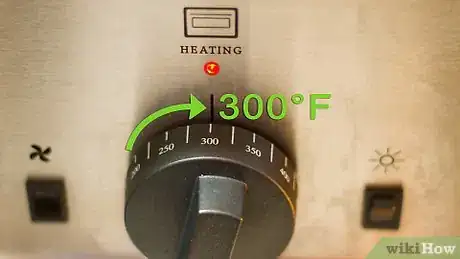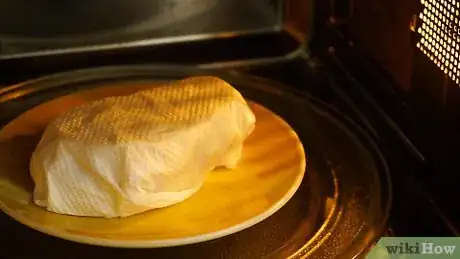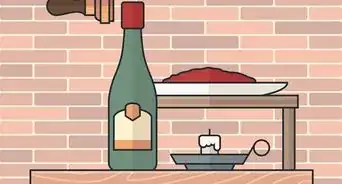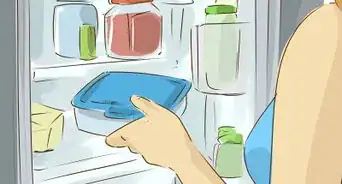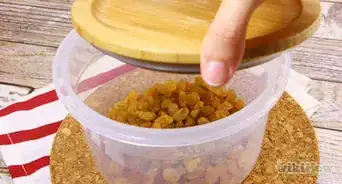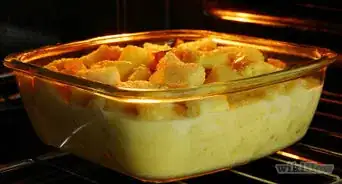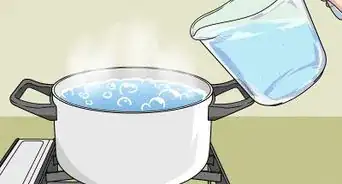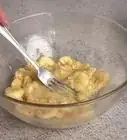This article was co-authored by wikiHow Staff. Our trained team of editors and researchers validate articles for accuracy and comprehensiveness. wikiHow's Content Management Team carefully monitors the work from our editorial staff to ensure that each article is backed by trusted research and meets our high quality standards.
There are 10 references cited in this article, which can be found at the bottom of the page.
The wikiHow Culinary Team also followed the article's instructions and verified that they work.
This article has been viewed 272,351 times.
Learn more...
Before you throw out hard, stale bread products, try restoring its texture with heat and moisture. This is most effective if the bread was kept wrapped and still has a little give, but it can even improve rock-hard loaves to some extent.
Steps
Heating in the Oven
-
1Preheat your oven to a low temperature. Set your oven to 300ºF (150ºC). The heat will restore most stale bread, although the effect will only last a few hours.[1]
-
2Add water only if the crust is hard. Even stale bread still contains plenty of water. It feels dry because the starch molecules have linked up and trapped the water. This means you don't need to add water to the crumb of the bread. If the bread has a hard outer crust, flick water onto it, or run it under the cold tap if extremely stale.[2]
- If the bread turned dry from overheating, or if it was exposed to air, it has lost some of its water.[3] Wet the whole loaf to restore moisture.
Advertisement -
3Wrap the bread in foil. This prevents steam from escaping, keeping the moisture trapped in the bread instead.
-
4Heat until soft. If you dampened the bread, wait until it no longer feels soggy. Depending on the size of the loaf and whether or not you added water, this could take 5–15 minutes.
-
5Unwrap and heat for another five minutes if the crust is too soft. If the bread is soft but the once-hard crust is squishy, take off the foil. Keep heating for another five minutes, or until you've restored the crust to the right texture.[4]
-
6
Steaming
-
1Bring water to a boil in the base of a steamer. Pour a shallow layer of water into the pan. Heat over high until the water reaches a rolling boil, then remove from heat.
- If you don't have a steamer, you'll need a colander that sits on top of the pan, and a lid that can fit over the colander.
- This methods adds less heat than the oven, but more moisture. The extra moisture is most helpful when the bread is very stale and hard, or if it was left out unwrapped.
-
2Place the stale loaf in the steamer basket. Place the basket over the steaming pan and cover with a lid.
-
3Leave covered until the bread is soft. Give the steam at least five minutes to soften the bread.
Microwaving
-
1Slice bread to eat right away. Microwaves do soften bread, but the results aren't perfect. Within a few minutes, the bread usually turns rubbery and even tougher than before.[8] This is the fastest method, but it's best to save it for an immediate snack.
- This happens because the microwave boils away some of the water. The escaping steam pushes the starches into a denser structure, and leaves the bread dry. Slow heating in small increments can reduce this effect, but it's difficult to find a sweet spot that's still hot enough to soften the bread.
-
2Wrap in a damp paper towel. Lightly dampen a plain, white paper towel. Wrap it around your bread.[9] This adds more moisture, and traps some of the steam in the bread to keep it soft.
-
3Heat in ten second intervals. Depending on how strong your microwave is, the bread might already be soft after ten seconds. If not, try again, checking frequently.
Community Q&A
-
QuestionWhy does hard bread become soft when I wet it?
 Community AnswerBecause it brings the moisture back. When wet starch (i.e. dough) heats up (i.e. baked, it becomes partially gelatinized. That's the nice, moist texture of fresh baked bread.
Community AnswerBecause it brings the moisture back. When wet starch (i.e. dough) heats up (i.e. baked, it becomes partially gelatinized. That's the nice, moist texture of fresh baked bread. -
QuestionWhy does microwaved bread become even harder than before?
 Maggie PetersonCommunity AnswerMicrowaving bread causes it to lose moisture. Trying putting a mug of water in the microwave when you microwave the bread. The steam will help keep the bread soft.
Maggie PetersonCommunity AnswerMicrowaving bread causes it to lose moisture. Trying putting a mug of water in the microwave when you microwave the bread. The steam will help keep the bread soft.
Warnings
- Overheating the bread will boil away moisture and make it tough and dry. This is easy to do in the microwave, due to uneven heating.⧼thumbs_response⧽
- The refrigerator may prevent mold from growing on your bread, but it won't keep it fresh. Starch retrogradation (the process that makes bread go stale) happens much faster at cold temperatures (above freezing).[12]⧼thumbs_response⧽
References
- ↑ http://www.sciencedirect.com/science/article/pii/S0733521005000652
- ↑ https://www.cooksillustrated.com/how_tos/8226-how-to-revive-stale-bread
- ↑ https://play.google.com/store/books/details?id=bKVCtH4AjwgC
- ↑ https://www.cooksillustrated.com/how_tos/8226-how-to-revive-stale-bread
- ↑ https://ift.onlinelibrary.wiley.com/doi/pdf/10.1111/1541-4337.12143
- ↑ https://www.cooksillustrated.com/how_tos/8226-how-to-revive-stale-bread
- ↑ http://www.bloomberg.com/view/articles/2013-08-19/what-makes-bread-go-stale-
- ↑ http://www.ncbi.nlm.nih.gov/pubmed/17625869
- ↑ https://www.thekitchn.com/how-to-soften-hard-bread-138150
- ↑ http://www.e-reading.club/bookreader.php/151440/Figoni_-_How_baking_works__exploring_the_fundamentals_of_baking_science.pdf
- ↑ http://www.seriouseats.com/2014/06/does-refrigeration-really-ruin-bread.html
- ↑ http://ssu.ac.ir/cms/fileadmin/user_upload/Mtahghighat/tfood/asil-article/q-z2/Retrogradation-behaviour-of-high-amylose-rice-starch-prepared-by-improved-extrusion-cooking-technology_2014_Food-Chemistry.pdf
About This Article
If you want to make stale bread soft again, wrap the bread in foil. If the crust of the bread is very hard, sprinkle a little water on the outside before you close the foil. Place the bread in a 300°F oven for 5-15 minutes or until the bread feels soft. If you added water, heat the bread until it no longer feels soggy. Eat the bread right away, since it will only stay soft for a few more hours. To learn how to steam stale bread to make it soft again, keep reading!
